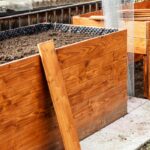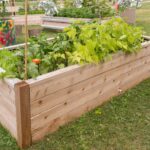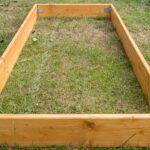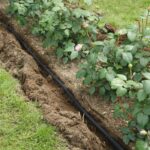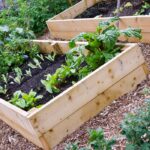Raised garden beds make a great addition to any home garden. They are aesthetically pleasing to look at and can offer a variety of helpful ways to grow your vegetables in ideal circumstances when perhaps, your ground soil isn’t the best. With an early start to the season, many vegetables thrive with the extra few weeks a raised garden bed can add to the growing time and produce hearty and bountiful harvests.
Raised garden beds can grow many plants, from beans, tomatoes, peppers, leafy greens, and root vegetables. The warm, well-draining soil allows for an early planting season most plants love. When planting in a raised bed, consider the soil type, sun requirements, and mature plant size.
A raised garden bed can offer prime real estate to your vegetable garden. With its optimal conditions, many vegetables thrive in their unique needs. So it’s essential to plant the proper kind of vegetables but also utilize the space adequately, without overcrowding, to ensure a plentiful harvest of your homegrown food.
Which Vegetables Grow Best in a Raised Garden Bed?
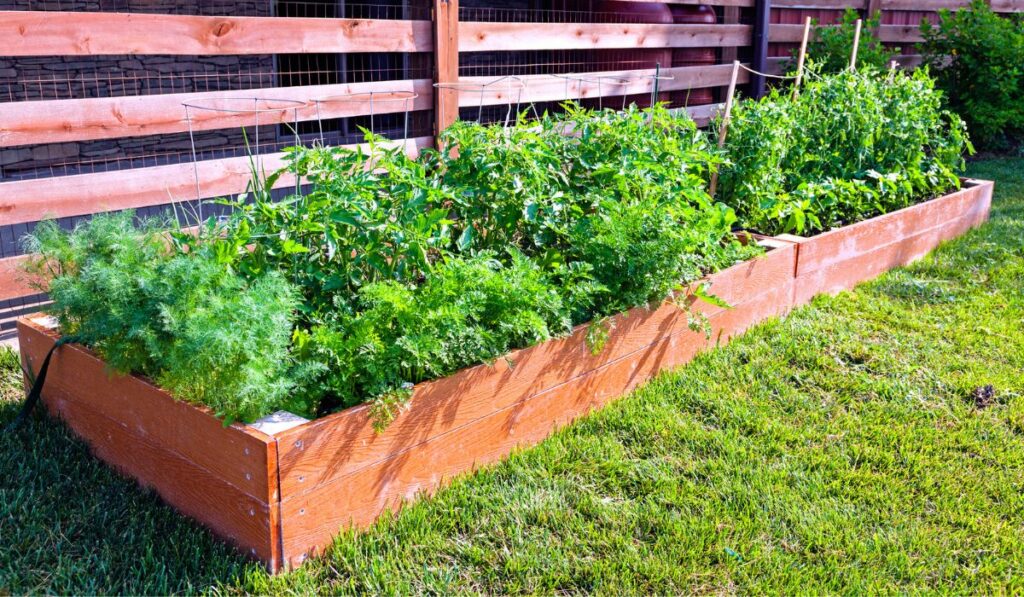
Knowing what kind of vegetables grow best in a raised garden bed could be the difference between having a successful harvest to one that barely survives the season.
Bush Beans
Bush beans (seeds on Amazon) are quick, easy, and compact, making them ideal for growing in raised garden beds. Many varieties become harvestable after only 50 to 55 days from seeding.
They can be planted right after the last frost, but you want to ensure the soil isn’t too wet or cold, or the seeds will rot instead of germinating.
Due to this requirement, the raised garden beds make a perfect place to plant bush beans, considering their soil gets warmer faster and earlier in the season.
Bush beans are incredibly easy to grow since they don’t require any support, but pole beans are also an option for the raised garden bed. They can grow upwards of six to nine feet tall and should be grown alongside bean towers, bamboo posts, or netting.
Sweet and Hot Peppers
You can grow many types of sweet and hot peppers (seeds on Amazon) in your garden, and almost all of them work in a raised bed. Generally, they require warm, well-draining soil, and the raised aspect of the garden bed will be able to provide that warm soil they need.
To get the best plants, try transplanting seedlings early in the season since they adapt easily and mature quickly with rapid growth. Then, with regular watering and mulch or straw to encourage healthy growth, you will have a bountiful harvest of sweet and hot peppers.
Tomatoes
Planting tomatoes (seeds on Amazon) in a raised garden bed can help you get a head start in the growing season, considering they need warm soil. Tomatoes aren’t typically planted until mid-June when the ground soil is warm.
However, with a raised garden bed, you can start planting in late May, giving them several more weeks in the growing season.
Deep, loose soil allows you to plant the tomato seedlings deeply, which promotes the development of roots along a portion of the stem that remains under the soil. The larger the root system, the bigger and healthier the plant will allow more water and nutrients to be collected and utilized. For added protection, consider covering your soil with a layer of mulch to keep it moist and prevent weeds.
One thing to note about growing tomatoes in raised garden beds is that there are two kinds: determinate and indeterminate.
Determinate varieties are called bush tomatoes and grow three to four feet tall, while indeterminate, or vining tomatoes, can grow up to seven feet tall.
Both can be grown in your raised garden bed, but the latter requires strong stakes or supports to grow. Indeterminate requires a little extra work, with new growth needing to be tied to the stakes almost weekly.
Cucumbers
Cucumbers are sensitive to cold soil and air temperatures, making the warmer environment of a raised garden bed better for their growth. In addition, early sowing is better for cucumber seeds or seedlings, which can be accomplished with a raised bed.
There are two kinds of cucumbers: bush and vining. Bush cucumbers grow only a few feet long and do well in containers or raised garden beds.
You can use tomato cages to support the plant, but they will also grow over the sides of the raised bed. So keep that in mind if you want clean pathways between the raised beds.
Vining cucumbers can also be grown in raised garden beds but must be placed at the base of a trellis or A-frame trellis to support their extensive growth. The plus side of growing vining cucumbers is they have fewer issues with insects and diseases and are also easier to spot the mature vegetable.
Root Vegetables
Root vegetables make the perfect crop to flourish in a raised garden bed. Carrots, beets, radishes, and parsnips are great in a raised bed’s warm, loose, and rock-free soil.
However, when you’re growing plants for the roots, in this case, where the vegetable grows, it’s essential to have complete control over the soil, and when planted in the ground, it is hard to maintain its conditions.
Rocks, clay, and debris can all hinder the growth of root vegetables and cause them to develop in odd shapes and sizes.
Leafy Greens
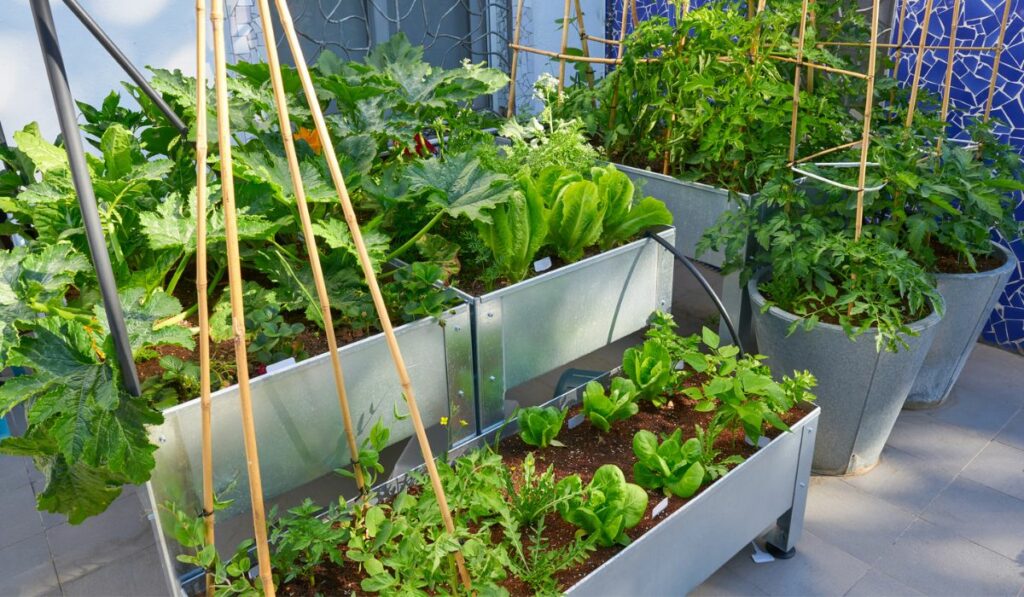
Different varieties of lettuce, spinach, and kale do well in raised garden beds. They can be planted in early spring once the soil is thawed and are fast-growing in rich soil with added compost or manure.
It’s also incredibly easy to sow the seeds or tuck the seedlings along the edges of your garden beds since they don’t take up much space.
In addition, quick-growing arugula or lettuce make great additions to a garden by interplanting them between slower-growing crops like tomatoes or peppers.
Onions
Compacted soil can be the worst enemy for onions, making raised garden beds ideal for loose, well-draining soil.
You can plant them 6 inches apart in early spring with an inch or two of compost. With the long growing season they require, the ability to plant them earlier in the season will allow that extra growing time to ensure the plant has large bulbs to harvest.
Which Vegetables Should Not Be Grown in a Raised Garden Bed?
There aren’t many vegetables that can’t grow in a raised garden bed. However, the space is always considered prime real estate for home gardens. So, while most vegetables can be planted in a raised garden bed, it’s also about considering the best use of space.
Herbs, for instance, are generally small and can be planted in pots and placed on a tiered plant stand that encourages easy access.
Annuals like cilantro and basil, and perennials like rosemary and sage, can be planted in alternative ways to maximize the best use of your raised garden bed.
On the flip side, some vegetables grow large and wide, such as zucchini, pumpkins, melons, and squash. Unfortunately, all these kinds of vining plants that grow wide instead of tall can quickly and easily take over the entire garden bed and starve out the rest of the vegetables you’ve planted.
What to Consider Before Planting Your Vegetables
Before going ahead and planting your vegetables in your raised garden beds, there are a few things to consider.
The first is the location of the raised bed and what kind of sunlight requirements the crop calls for. Planting a full sun plant in a partly shaded garden bed will hurt the growth of the vegetable, and you might not get the plentiful harvest you were hoping for.
There is also the soil to consider. Does the plant need sandy or heavy soil? Does it like compact or loose? Warm or cool?
There are many different needs for each vegetable plant, and some contradict each other. Planting vegetables that complement one another and have the same soil requirements will help in the long run.
Lastly, the garden bed’s size and how big a mature plant will get. If you’re planting pole beans and tomatoes, you’ll need some stake or cage to help stabilize the plant as it matures. If it’s a wide plant like zucchini, you want to make proper arrangements for its extensive vine system that tends to go anywhere it can reach.
Calculating how big a mature plant will get and how much room you have in the raised garden bed will stop any overcrowding issues that could lead to disease and plant death.

